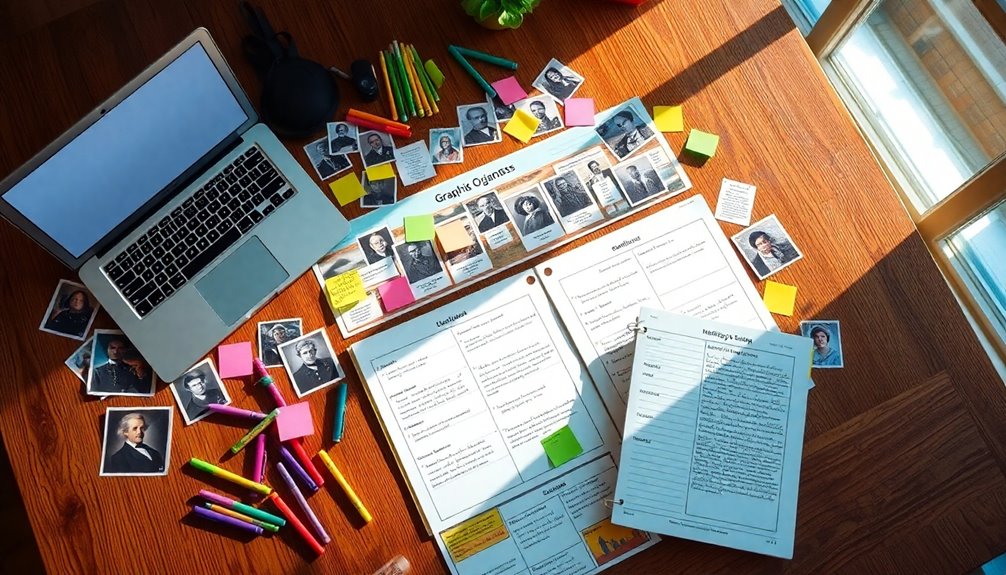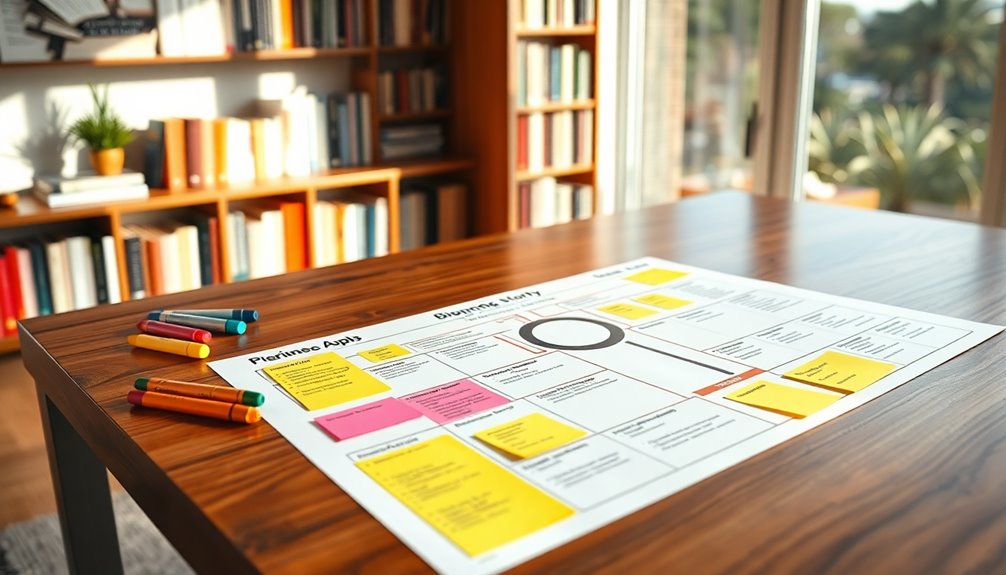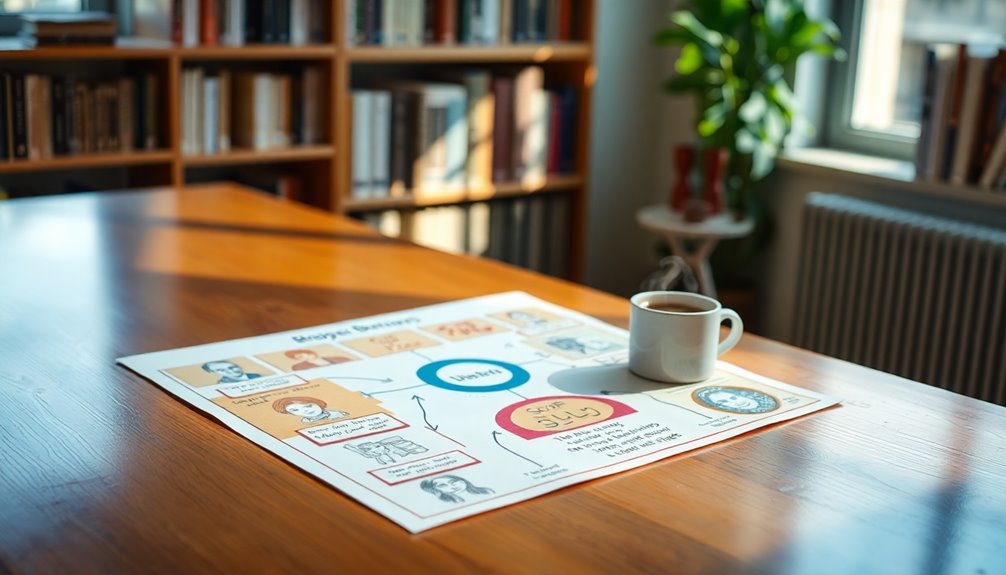A biography graphic organizer is your ultimate weapon for crafting a fascinating story that brings a person's life to light. It helps you organize essential details like early life, significant achievements, and unique anecdotes. You can choose from various types, such as Venn diagrams or sequence chains, to fit your needs. This tool simplifies complex information, enhances understanding, and supports different learning styles. Plus, plenty of templates and online resources can guide you in the process. With the right approach, you'll uncover the elements that make a biography truly engaging and impactful. There's much more to explore!
Key Takeaways
- Utilize a structured graphic organizer to outline key life events, ensuring a clear and captivating narrative flow.
- Incorporate early life details to establish context and connect with the audience emotionally.
- Highlight major achievements and challenges to create a compelling story arc that engages readers.
- Include interesting facts and personal anecdotes to add depth and relatability to the biography.
- Reflect on the individual's legacy to emphasize their impact on society and leave a lasting impression.
Purpose of a Biography Graphic Organizer

A biography graphic organizer serves as a valuable tool for anyone looking to explore a person's life story. It visually represents the subject's biography from a third-person perspective, making it easier for you to gather and organize essential information. By breaking down complex details into manageable parts, it guarantees a clear and logical presentation of the life story.
This organizer enhances your comprehension and retention of the material. Its visual cues reinforce learning, helping you connect new information to what you already know. As you trace the person's growth and development, you'll find it easier to remember the details for the long term. Additionally, it aids in organizing key biographical information, which is crucial for writing coherent and engaging biographies.
Moreover, it supports diverse learning styles. Whether you're a visual, auditory, or kinesthetic learner, this tool accommodates your needs, making the learning process inclusive. It's especially beneficial for those with special needs, as it simplifies information.
Key Components to Include

When creating a biography graphic organizer, it's important to know which key components to include for a detailed overview of a person's life. Start by documenting their early life and background. Include their birth date and place, parents' names, siblings, and details about their childhood home. This sets the stage for understanding their formative years.
Next, focus on major life events and achievements. Highlight key milestones, education, career highlights, and any significant contributions they made to society. Don't forget to mention major awards or honors they received.
Family life and relationships are essential too. Document their spouse(s), children, and extended family members. Discuss close friends or mentors, along with family traditions or values that shaped them. This adds depth to their personal narrative. Additionally, employing tools such as customizable templates can help in organizing biographical information effectively.
Lastly, include interesting facts and legacy. Note any unique hobbies, challenges faced, and lessons learned throughout their life. Reflect on their lasting impact on society and how they're remembered. By covering these key components, you'll create a thorough and engaging biography graphic organizer that captures the essence of the individual.
Types of Graphic Organizers

Graphic organizers serve as powerful tools to enhance learning and comprehension. They help you visualize relationships, categorize information, and structure ideas effectively. Here are some popular types:
| Type | Description | Uses |
|---|---|---|
| Venn Diagram | Compares and contrasts concepts using overlapping circles. | Identify similarities and differences between characters or events. |
| T-Chart | Features two columns to classify concepts or events. | Examine cause and effect or facts and opinions. |
| Sequence Chain | Organizes events in a story with boxes and arrows. | Visualize timelines or steps in a process. |
Using these graphic organizers can greatly improve your understanding of complex topics. For instance, a Venn Diagram can clarify the relationships between two characters in a biography, while a T-Chart can help you explore the causes behind key events. Additionally, employing graphic organisers can aid in simplifying complex information and facilitate deeper understanding. Engaging in literary engagement can further enhance the effectiveness of these tools as you craft your captivating stories. Embrace these tools to streamline your thought processes and enhance your storytelling.
Benefits for Student Learning

Utilizing graphic organizers offers numerous benefits for student learning, making complex information more approachable. They simplify intricate ideas by breaking them down into smaller, manageable parts, helping you visualize relationships between concepts with shapes, symbols, and connectors. This structured presentation enhances understanding and reduces overwhelm, allowing you to grasp the big picture effectively. Additionally, they are known to enhance teaching and learning by providing a visual framework that captures students' attention.
Here are some key benefits of using graphic organizers:
- Simplifies Complex Information: Breaks down large amounts of content into logical segments, making it easier to digest.
- Improves Comprehension and Retention: Combines text and visuals, reinforcing learning and aiding long-term memory.
- Supports Diverse Learning Styles: Caters to visual, auditory, and kinesthetic learners, promoting an inclusive approach.
- Encourages Critical Thinking and Engagement: Fosters problem-solving skills and makes learning interactive and enjoyable.
- Facilitates Collaboration: Promotes group work, enhancing social skills and collective learning experiences.
Tools and Resources Available

A variety of tools and resources are at your disposal to create engaging biography graphic organizers. You can start with graphic organizer templates that include pamphlets, brochures, and charts. These templates typically feature sections for essential information like the person's name, dates, early life, family details, major events, and accomplishments. Many even allow space for a picture and introductory information, and you can customize them to suit your needs.
For a more interactive experience, online biography makers like EdrawMax and Creately offer extensive templates and symbol libraries. With drag-and-drop tools and smart formatting options, you can easily create visually appealing organizers and export them in formats like PDF, JPEG, or SVG. Additionally, understanding the importance of a budget can help you allocate resources for purchasing premium templates or tools.
Collaboration is made easy through platforms like Creately, which offer real-time features for video conferencing and whiteboarding. You control access levels, allowing specific roles for viewing or editing your project.
Additionally, free printable worksheets from sources like StoryboardThat and Teachers Pay Teachers can complement your efforts. Digital versions, including Google Slides, provide flexibility for classroom use and can be customized for different age groups. These resources will help you craft an engaging biography graphic organizer.
Including a variety of biographical formats in your graphic organizer can enhance understanding of the subject's life and contributions.
Frequently Asked Questions
How Do I Choose the Right Biography Subject?
To choose the right biography subject, reflect on your interests and how they connect to the subject's life. Consider their historical significance, available resources, and how their story can resonate with your audience.
Can I Use a Graphic Organizer for Fictional Characters?
Picture mapping out a character's journey, thoughts swirling like autumn leaves. A graphic organizer helps you capture their traits, emotions, and growth, making it easier to understand and connect with their story.
What Age Group Is Best Suited for Biography Projects?
The best age group for biography projects is middle school. At this stage, you're developing critical research and writing skills, and you can engage deeply with subjects while collaborating with peers for richer learning experiences.
How Can I Assess Student Work on Biography Graphic Organizers?
To assess student work on graphic organizers, check for organization, completeness, and relevance. Evaluate their categorization of achievements and guarantee they include key facts. Use rubrics for clarity and participation in presentations.
Are There Specific Themes to Focus on in a Biography?
When you explore a biography, focus on themes like triumph over adversity, personal growth, and relationships. These threads weave a rich tapestry, revealing the resilient spirit and vibrant life experiences that shape individuals.










